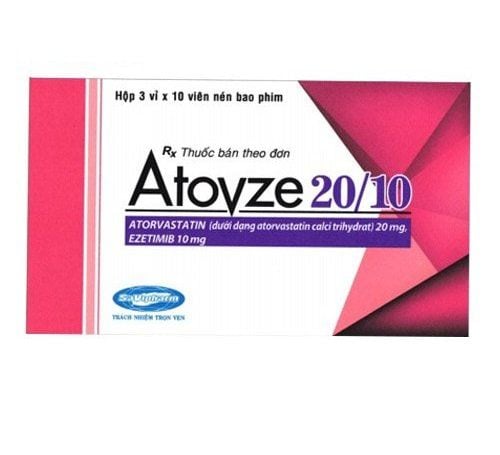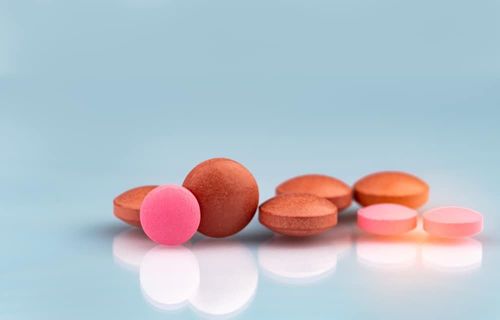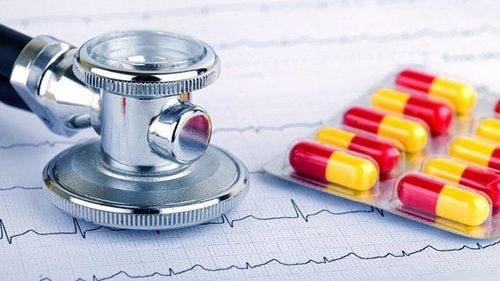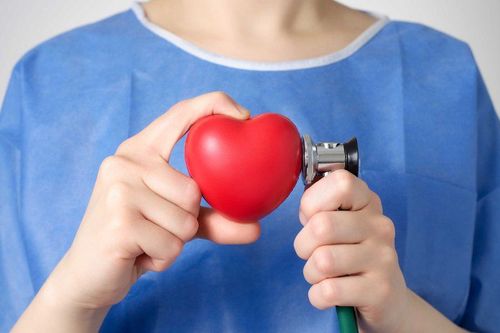This is an automatically translated article.
Coronary artery disease (CAD) is very common, even the most common type of heart disease. Although it is the leading cause of death in the world, there are many things you can do to prevent or treat it.
1. Causes of coronary artery disease
Starting at a young age, plaque - a combination of cholesterol, fat and other substances - begins to stick to the walls of your blood vessels. It builds up over time, causing the arteries to become stiffer and narrower, which doctors call atherosclerosis.
In some cases, the plaque may crack or break. There, blood cells called platelets arrive, trying to "repair" the artery and form a clot. Like plaque that clogs water pipes, this buildup blocks the free flow of blood through the arteries. Blood carries oxygen and nutrients to the heart. If the heart doesn't get enough, it can lead to shortness of breath and chest pain (angina).
Without enough oxygen, the heart can become weaker. This can lead to an irregular heartbeat (arrhythmia). It can also cause heart failure, which means the heart can't pump enough blood around to meet the body's needs.
If a plaque grows so large that it stops blood flow to the heart muscle, you could have a heart attack. Most of the time, however, heart attacks occur from small broken pieces.
2. Symptoms of coronary artery disease
In the early stages, you may not have any symptoms. But as plaque continues to build up and restrict blood flow to the heart muscle, you may notice that you're short of breath or tired, especially during exertion.
The most common symptom of CAD is angina. Some people mistake it for heartburn or indigestion.
With angina, your chest feels uncomfortable. You may also experience pain in your shoulder, arm, back, or jaw. You may feel: Chest tightness, Uncomfortable, Heaviness in the chest, Constriction, Burning, Chest pressure, Feeling of fullness, Pain....
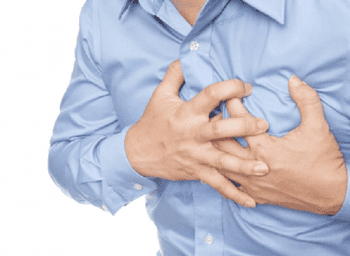
Triệu chứng phổ biến nhất của BMV là đau thắt ngực
Chest pain, especially in the middle or left side of the chest, lasts for several minutes, or goes away and comes back. You may feel like pressure, squeezing, fullness, or pain. Some people mistake it for indigestion or heartburn. Discomfort in any part of your upper body. It can be in one or both arms, shoulders, neck, jaw, or the upper part of the stomach. Shortness of breath, with or without chest discomfort Nausea or vomiting, dizziness or cold sweats Women often have different heart attack symptoms than men. While chest pain is still predominant, women are more likely to experience other symptoms, such as shortness of breath, extreme fatigue, nausea, vomiting, and back or jaw pain.
3. High-risk subjects for coronary artery disease
Coronary artery disease (BMV) is more common as you get older or if you have a family member with it. You may also have many other risk factors for coronary heart disease, including: High cholesterol and triglycerides High blood pressure Smoking Less exercise Stress, depression and anger Unhealthy diet Drinking too much alcohol Metabolic syndrome Diabetes

Căng thẳng, trầm cảm là 1 trong những nguy cơ gây bệnh động mạch vành
4. How is coronary artery disease diagnosed?
Your doctor will examine you and talk to you about your symptoms, risks, and family history. You may also be ordered to have tests such as:
Electrocardiogram (ECG): Measures the electrical activity of the heart and possibly evaluates for heart damage Stress testing, which includes walking on a treadmill or cycling onsite in the clinic while monitoring your diabetes, heart rate, and blood pressure. Your doctor may also do an echocardiogram during exercise to more accurately assess myocardial ischemia. Chest X-ray Blood tests to check blood glucose, cholesterol, and triglyceride levels Coronary angiography : The doctor threads a very thin, soft tube (called a catheter) through a blood vessel in your arm or thigh into your heart. Your doctor injects contrast material through the catheter and then uses X-ray video to view your blood vessels and heart chambers.
5. Treatment of coronary artery disease
Depending on your medical condition, your treatment plan may include:
Lifestyle changes: This has been shown to work well
Prioritize low-fat, low-fat foods sugar and sodium. If you smoke, quit. Move daily, ideally for 30 minutes or more each day (ask your doctor first if there are any restrictions on exercise). Strive for a healthy, reasonable body weight. Learn effective ways to manage your stress. Drug treatment:
If the above lifestyle changes aren't enough, you may also need medication to help keep your heart healthy. These may include blood thinners (anticoagulants – aspirin) and other anticoagulants, ACE inhibitors, beta blockers, nitroglycerin, calcium channel blockers, statins, or PCSK9. Revascularization:
This procedure can reopen blocked or narrowed arteries without surgery on your chest. For angioplasty, your doctor threads a small, soft tube with a small balloon at the end, through your blood vessels until it reaches the blocked artery. The doctor then inflates the balloon, forcing the artery to open so more blood can flow. In many cases, a small tube called a stent is also inserted to keep the blood vessel from collapsing. You will stay in the hospital for a few days or less. Coronary bypass surgery:
Coronary artery bypass surgery is a type of surgery in which doctors use blood vessels from other parts of your body to make a bypass through your blocked coronary artery. It's a major procedure and you may need to stay in the hospital for at least 5 days.
6. Prevention of coronary artery disease

Luyện tập thể dục đều đặn
Stay alert to your coronary heart disease risk factors. Talk to your doctor about controlling cholesterol, blood pressure, and blood sugar. If you have high cholesterol, high blood pressure, or diabetes, it's important to keep those conditions under control.
Set a reasonable weight adjustment goal. If you're not sure what your goal weight is, ask your doctor. And even if you should theoretically lose a lot of weight, remember that even a small amount of weight loss has health benefits.
Avoid secondhand smoke: if you smoke, quit. Stay away from smoke.
Limit alcohol: A little alcohol may have some benefits for the heart, but too much is high risk. Men should have no more than two drinks of alcohol and women should have no more than one drink per day.
Eat smart. Avoid fat (found in many baked goods and fried and processed foods). Eat plenty of foods rich in fiber, such as fruits and vegetables, whole grains, and beans. Limit saltiness. Eat more fatty fish, such as salmon, tuna or mackerel.... Because they are high in heart-healthy omega-3 fats.
Exercise regularly. You need to get at least 30 minutes of moderate-intensity exercise (like gardening or riding a bike that makes your heart beat faster but not too strenuous) for 5 or more days per week. Talk to your doctor before you start a new exercise session.
Manage your stress level. Use measures like exercise, meditation, and other healthy activities to help you relax.
Cardiovascular Center of Vinmec Times City International Hospital has been in operation for many years, has a full range of specialties: Cardiology intensive clinic, Cardiology inpatient area (separate inpatient room, intensive care units: HDU, CICU), interventional cardiology and cardiac surgery units; with a team of leading cardiologists in consultation as well as participating in interventional and surgical treatment.
The Interventional Cardiology Unit is equipped with synchronously and a lot of modern equipment (rooms: Cath-Lab, Angio-CT, Hybrid Room) that can fully meet the interventions and intensive surgery, comes with FDA and ISO certified best medical supplies (all 100% new used on all patients).
Currently with the cost support (50% - 100%) from Vingroup's Benevolent Fund for cardiovascular patients, many patients' lives are saved thanks to modern techniques such as aortic stentgraft. , transcatheter aortic valve replacement (TAVI), left ventricular device implantation for patients with end-stage heart failure (LVAD)..., and is striving to become an independent center for TAVI in the North .
Particularly for coronary artery disease, currently Vinmec Times City International Hospital has well performed all surgical interventions from the simplest to the most complex in coronary artery disease (common trunk injury, branching lesions, chronic completely occlusive lesions -CTO, as well as coronary artery bypass grafting...) comes with a full range of modern diagnostic systems such as: Stress echocardiography, Electrocardiography. exercise cardiogram, SPECT-CT to assess myocardial survival..., as well as assistive devices in coronary artery surgery such as: FFR, IVUS, Rotablator...
Please dial HOTLINE for more information or register for an appointment HERE. Download MyVinmec app to make appointments faster and to manage your bookings easily.




